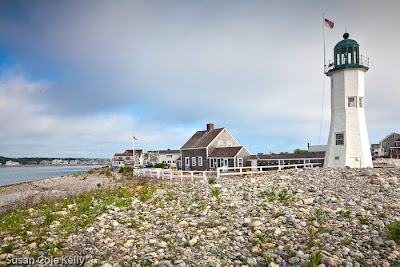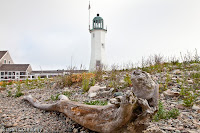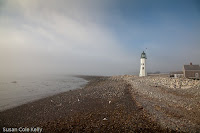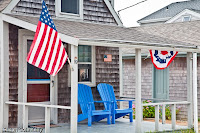
The weather has been humid lately and mornings have been foggy. Foggy photos can be charming, but fog and mist present challenges that need to be dealt with. Cameras are calibrated to make good exposures in average conditions. "Average" is the tone of summer grass and blue sky, paved streets, and brick walls. When a camera encounters a scene that's supposed to be very light or very dark, it mistakenly tries to make the exposure average.
You've seen photos with gray fog. Fog is not gray! When you step outside on a foggy morning, the sky is white. Yet the camera makes everything look gray. This is one situation where the photographer needs to use camera settings to override the tendency to make everything average.
 -
- 
The picture on the left is underexposed, with a gray sky and dark foreground. That is not what I saw as I approached this lighthouse. Fog is white, not gray! My camera has an EV control, which I set at +1 or +1.5. My compact camera has a "Snow" setting which lightens exposures. Yes, snow and fog scenes have the same exposure problem.
 Now that the exposure is set right, the next problem is that everything is white and not very interesting. The way I work with this is to put something in the foreground that is dark or bright. In foggy situations, the fog has an incremental effect. Distant objects are lighter than close objects. Here the driftwood log adds some foreground interest and balances all that white in the sky.
Now that the exposure is set right, the next problem is that everything is white and not very interesting. The way I work with this is to put something in the foreground that is dark or bright. In foggy situations, the fog has an incremental effect. Distant objects are lighter than close objects. Here the driftwood log adds some foreground interest and balances all that white in the sky.The really great thing about morning ground fog is that it clears away, usually by 9:00. I took a walk, made some pictures of beach houses in the (gorgeous) even light, and returned to the lighthouse as the fog lifted. At this point, it becomes apparent that fog is just a cloud on the ground. The sun warms it and it rises, creating interesting effects as it clears out. Including blue sky and foreground elements makes pictures of clearing fog interesting and unique. If you're lucky enough to see this at sunrise or sunset, you can get spectacular lighting and color and God-rays. I wasn't that lucky this week, but I'll keep on trying!
 -
-  -
- 
I finished off these images in Adobe Lightroom, my favorite post-processing software. One of the pictures needed more help because the lighthouse was leaning toward the center. I fixed the perspective distortion in Photoshop and, while I was diddling, I used the HDR-tone adjustment to bring out the details. How did I do? Does it look natural? Which one is it?
